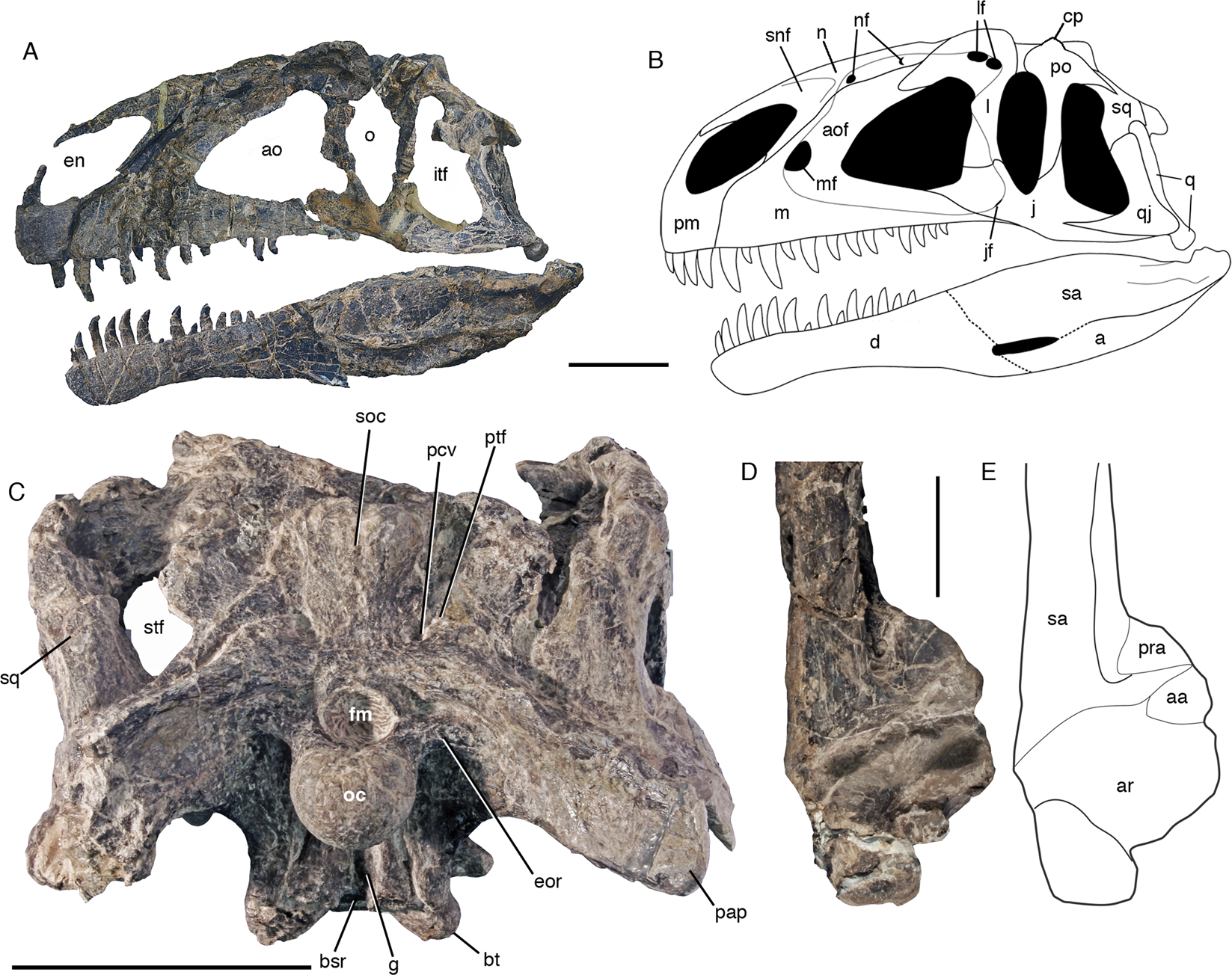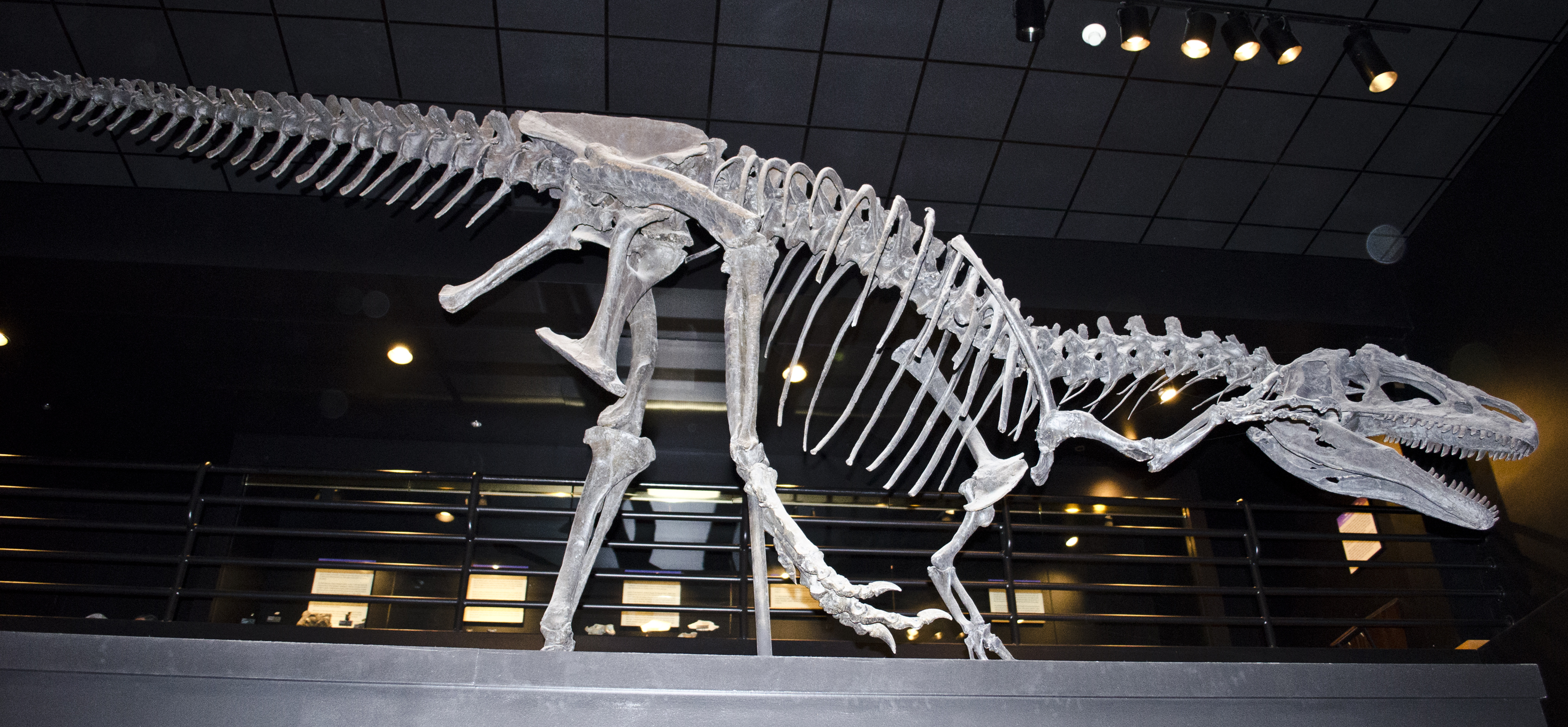|
Allosauroid
Allosauroidea is a superfamily or clade of theropod dinosaurs which contains four families — the Metriacanthosauridae, Allosauridae, Carcharodontosauridae, and Neovenatoridae. Allosauroids, alongside the family Megalosauroidea, were among the apex predators that were active during the Middle Jurassic to Late Cretaceous periods. The most famous and best understood allosauroid is the North American genus ''Allosaurus''. The oldest-known allosauroid, '' Shidaisaurus jinae'', appeared in the early Middle Jurassic about 174 million years ago (Earliest Aalenian stage) of China. The last known definitive surviving members of the group died out around 89 million years ago in Asia (''Shaochilong'') and South America (''Mapusaurus''), though the megaraptorans, which survived until the end of Maastrichtian, may belong to the group as well. A frontal assigned to an allosauroid found to be most closely related to ''Sinraptor'' has also been found in the Coniacian (89-86.3 Ma) of Argen ... [...More Info...] [...Related Items...] OR: [Wikipedia] [Google] [Baidu] |
Megaraptora
Megaraptora is a clade of carnivorous Tetanurae, tetanuran theropod dinosaurs with controversial relations to other theropods. Its Derived (phylogenetics), derived members, the Megaraptoridae are noted for their elongated hand claws and proportionally large arms, which are usually reduced in size in other large theropods. Megaraptorans are incompletely known, and no complete megaraptoran skeleton has been found. However, they still possessed a number of unique features. Their forelimbs were large and strongly built, and the Glossary of dinosaur anatomy#ulna, ulna bone had a unique shape in members of the Family (biology), family Megaraptoridae, a subset of megaraptorans which excludes ''Fukuiraptor'' and ''Phuwiangvenator''. The first two fingers were elongated, with massive curved claws, while the third finger was small. Megaraptoran skull material is very incomplete, but a juvenile ''Megaraptor'' described in 2014 preserved a portion of the snout, which was long and slender. Le ... [...More Info...] [...Related Items...] OR: [Wikipedia] [Google] [Baidu] |
Metriacanthosauridae
Metriacanthosauridae is an extinct family of allosauroid theropod dinosaurs that lived from the Middle Jurassic to the Early Cretaceous. When broken down into its Greek roots, it means "moderately-spined lizards". The family is split into two subgroups: Metriacanthosaurinae, which includes dinosaurs closely related to ''Metriacanthosaurus'', and another group composed of the close relatives of ''Yangchuanosaurus''. Metriacanthosaurids are considered carnosaurs, belonging to the Allosauroidea superfamily. The group includes species of large range in body size. Of their physical traits, most notable are their neural spines.Bailey, Jack Bowman. "Neural Spine Elongation in Dinosaurs: Sailbacks or Buffalo-Backs?" Journal of Paleontology, vol. 71, no. 06, 1997, pp. 1124–1146., doi:10.1017/s0022336000036076. The records of the group are mostly confined to Asia, though ''Metriacanthosaurus'' is known from Europe. Metriacanthosauridae is used as a senior synonym of Sinraptoridae. Diagno ... [...More Info...] [...Related Items...] OR: [Wikipedia] [Google] [Baidu] |
Asfaltovenator
''Asfaltovenator'' (meaning "Cañadón Asfalto Formation hunter" after the fossil formation in which its fossils were found) is a genus of possibly allosauroid dinosaur from the Lower Jurassic Cañadón Asfalto Formation from Chubut Province, Argentina. The type and only species is ''Asfaltovenator vialidadi''. Discovery In 2002, technician Leandro Canesa, roughly a mile north of Cerro Condor, discovered a theropod skeleton. Excavations started in 2005. In 2007, the fossil was in its entirety removed as an enormous stone block, covered by plaster of Paris. It was then prepared by Mariano Caffa, a process that took five years due to the extreme hardness of the stone matrix. Between 2013 and 2015, it was compared with the specimens of related theropods, researchers personally investigating their exemplars in collections all over the world. In 2019, the type species ''Asfaltovenator vialidadi'' was named and described by Oliver Walter Mischa Rauhut and Diego Pol. The generic name ... [...More Info...] [...Related Items...] OR: [Wikipedia] [Google] [Baidu] |
Megalosauroidea
Megalosauroidea (meaning 'great/big lizard forms') is a superfamily (or clade) of tetanuran theropod dinosaurs that lived from the Middle Jurassic to the Late Cretaceous period. The group is defined as ''Megalosaurus bucklandii'' and all taxa sharing a more recent common ancestor with it than with ''Allosaurus fragilis'' or ''Passer domesticus''. Members of the group include ''Spinosaurus'', ''Megalosaurus'', and ''Torvosaurus''. They are possibly paraphyletic in nature. Classification The name Spinosauroidea is sometimes used in place of Megalosauroidea. The superfamily Spinosauroidea was named in 1915 by Ernst Stromer. It is a synonym of Megalosauroidea in almost all modern phylogenetic analyses, and it is therefore redundant. Spinosauroidea was defined as a clade in 1998 by Paul Sereno as the node clade containing the common ancestor of ''Spinosaurus'' and ''Torvosaurus'' and all its descendants. Thomas Holtz in 2004 defined a branch clade with the same name containing all spec ... [...More Info...] [...Related Items...] OR: [Wikipedia] [Google] [Baidu] |
Allosaurus
''Allosaurus'' () is a genus of large carnosaurian theropod dinosaur that lived 155 to 145 million years ago during the Late Jurassic epoch (Kimmeridgian to late Tithonian). The name "''Allosaurus''" means "different lizard" alluding to its unique (at the time of its discovery) concave vertebrae. It is derived from the Greek (') ("different, other") and (') ("lizard / generic reptile"). The first fossil remains that could definitively be ascribed to this genus were described in 1877 by paleontologist Othniel Charles Marsh. As one of the first well-known theropod dinosaurs, it has long attracted attention outside of paleontological circles. ''Allosaurus'' was a large bipedal predator. Its skull was light, robust and equipped with dozens of sharp, serrated teeth. It averaged in length for ''A. fragilis'', with the largest specimens estimated as being long. Relative to the large and powerful hindlimbs, its three-fingered forelimbs were small, and the body was balanced b ... [...More Info...] [...Related Items...] OR: [Wikipedia] [Google] [Baidu] |
Allosaurus Fragilis
''Allosaurus'' () is a genus of large carnosaurian theropod dinosaur that lived 155 to 145 million years ago during the Late Jurassic epoch (Kimmeridgian to late Tithonian). The name "''Allosaurus''" means "different lizard" alluding to its unique (at the time of its discovery) concave vertebrae. It is derived from the Greek (') ("different, other") and (') ("lizard / generic reptile"). The first fossil remains that could definitively be ascribed to this genus were described in 1877 by paleontologist Othniel Charles Marsh. As one of the first well-known theropod dinosaurs, it has long attracted attention outside of paleontological circles. ''Allosaurus'' was a large bipedal predator. Its skull was light, robust and equipped with dozens of sharp, serrated teeth. It averaged in length for ''A. fragilis'', with the largest specimens estimated as being long. Relative to the large and powerful hindlimbs, its three-fingered forelimbs were small, and the body was balanced b ... [...More Info...] [...Related Items...] OR: [Wikipedia] [Google] [Baidu] |
Dinosaur
Dinosaurs are a diverse group of reptiles of the clade Dinosauria. They first appeared during the Triassic period, between 243 and 233.23 million years ago (mya), although the exact origin and timing of the evolution of dinosaurs is the subject of active research. They became the dominant terrestrial vertebrates after the Triassic–Jurassic extinction event 201.3 mya; their dominance continued throughout the Jurassic and Cretaceous periods. The fossil record shows that birds are feathered dinosaurs, having evolved from earlier theropods during the Late Jurassic epoch, and are the only dinosaur lineage known to have survived the Cretaceous–Paleogene extinction event approximately 66 mya. Dinosaurs can therefore be divided into avian dinosaurs—birds—and the extinct non-avian dinosaurs, which are all dinosaurs other than birds. Dinosaurs are varied from taxonomic, morphological and ecological standpoints. Birds, at over 10,700 living species, are among ... [...More Info...] [...Related Items...] OR: [Wikipedia] [Google] [Baidu] |
Allosauridae
Allosauridae is a family of medium to large bipedal, carnivorous allosauroid theropod dinosaurs from the Late Jurassic. Allosauridae is a fairly old taxonomic group, having been first named by the American paleontologist Othniel Charles Marsh in 1878. Allosaurids are characterized by an astragalus with a restriction of the ascending process to the lateral part of the bone, a larger medial than lateral condyle, and a horizontal groove across the face of the condyles. Description Allosaurids have a general anatomy typical of other neotheropod dinosaurs, contributing to the difficulty in defining the family's membership. A typical 8m specimen of ''Allosaurus fragilis'' had a skull of about 0.85m. The premaxilla has five teeth and the maxilla usually around 16. The dentary also typically has 16 teeth. All teeth are serrated and continuously replaced throughout the life of the animal. Allosaurid skulls are characterized by two sets of crests formed by the nasal and lacrimal bones res ... [...More Info...] [...Related Items...] OR: [Wikipedia] [Google] [Baidu] |
Piatnitzkysauridae
Piatnitzkysauridae is an extinct family of megalosauroid or basal Allosauroid dinosaurs. It only consists of three known dinosaur genera: '' Condorraptor'', ''Marshosaurus'', and ''Piatnitzkysaurus.'' The most complete and well known member of this family is ''Piatnitzkysaurus'', which also gives the family its name. Description So far all known piatnitzkysaurids have only been found in Jurassic deposits of the western hemisphere/New world. ''Piatnitzkysaurus'' and ''Condorraptor'' hail from the Cañadón Asfalto Formation of Argentina, which has been dated from the Toarcian epoch of the Early Jurassic to the Bathonian epoch of the Middle Jurassic (approximately 179 to 168 million years ago). ''Marshosaurus'' was found in the Morrison Formation of the United States, which was dated to the Kimmeridgian epoch of the Late Jurassic. Piatnitzkysaurids were among the first large theropods present in South America, and are evidence for a radiation of basal tetanurans in the middle Jur ... [...More Info...] [...Related Items...] OR: [Wikipedia] [Google] [Baidu] |
Lusovenator
''Lusovenator'' (meaning "Portuguese hunter") is a genus of carcharodontosaurian theropod dinosaur, from the Late Jurassic (Kimmeridgian) Praia de Amoreira Porto-Novo Member and the Late Jurassic-Early Cretaceous (Tithonian-Berriasian) Assenta Member of the Lourinhã Formation in present-day Portugal. It includes one species, ''Lusovenator santosi''. Discovery and naming The holotype was discovered during the 1980s by José Joaquim dos Santos and he donated his fossil collection to the Sociedade de História Natural around thirty years later. The unnamed holotype was described and placed in the Allosauroidea in 2017. The neotype was described in 2019 and both specimens were placed within Carcharodontosauria.Malafaia, E., P. Mocho, F. Escaso, P. Dantas, and F. Ortega. 2019. "Carcharodontosaurian remains (Dinosauria, Theropoda) from the Upper Jurassic of Portugal". Journal of Paleontology 93 : 157–172 The species ''Lusovenator santosi'' was named and described in 2020. The known ... [...More Info...] [...Related Items...] OR: [Wikipedia] [Google] [Baidu] |
Neovenatoridae
Neovenatoridae is a proposed clade of carcharodontosaurian dinosaurs uniting some primitive members of the group such as ''Neovenator'' with the Megaraptora, a group of theropods with controversial affinities. Other studies recover megaraptorans as basal coelurosaurs unrelated to carcharodontosaurs. Other theropods with uncertain affinities such as ''Gualicho'', ''Chilantaisaurus'' and ''Deltadromeus'' are also sometimes included. Classification Phylogenetic studies conducted by Benson, Carrano and Brusatte (2010) and Carrano, Benson and Sampson (2012) recovered the group Megaraptora as members of the Neovenatoridae. This would make neovenatorids the latest-surviving allosauroids; at least one megaraptoran, ''Orkoraptor'', lived near the end of the Mesozoic era, dating to the early Maastrichtian stage of the latest Cretaceous period, about 70 million years ago. On the other hand, Novas ''et al.'' (2012), while confirming that ''Neovenator'' was closely related to carcharodontosau ... [...More Info...] [...Related Items...] OR: [Wikipedia] [Google] [Baidu] |
Erectopus
''Erectopus'' (meaning "upright foot") is an extinct genus of basal allosauroid theropod from the Early Cretaceous La Penthiève Beds Formation of France and also possibly the Cernavoda Formation of southern Romania. The type species is ''E. superbus'', which was initially known as a species of ''Megalosaurus''. Discovery and naming The holotype, specimen MNHN 2001-4, was discovered between the early 1870s and before 1882 in the Phosphate-bearing beds of La Penthiève (''Mammilatum'' Zone; lower Albian) at Louppy-le-Château in eastern France,Allain, R. (2005). The enigmatic theropod dinosaur ''Erectopus superbus'' (Sauvage, 1882) from the Lower Albian of Louppy-le-Château (Meuse, France). in Carpenter, K. 2005. ''The Carnivorous Dinosaurs'', Indiana University Press: 72-86. which have also produced remains of plesiosaurs, ichthyosaurs, and crocodiles. The fossils originally resided in the private collection of Louis Pierson. The first, two teeth and a vertebra, were firs ... [...More Info...] [...Related Items...] OR: [Wikipedia] [Google] [Baidu] |









.jpg)
